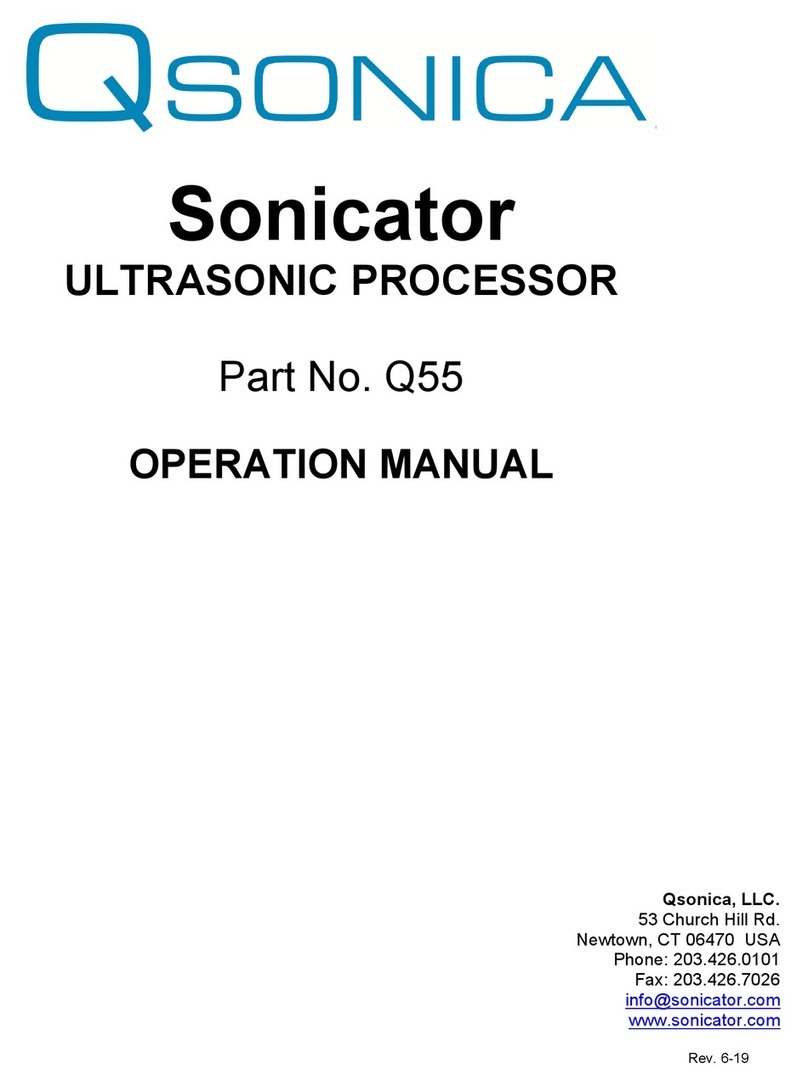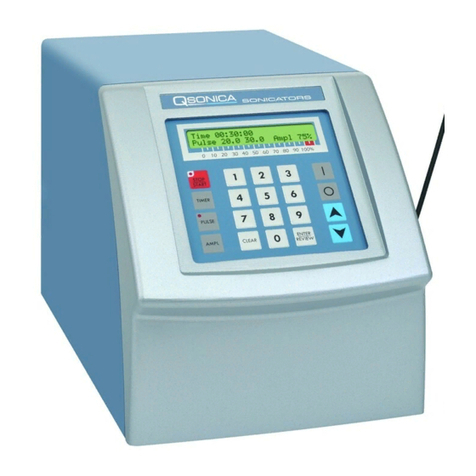
Rev. 3-11
8
4. Principles of Operation
T e ultrasonic electronic generator transforms AC line power to a 20 KHz signal t at drives a
piezoelectric converter/transducer. T is electrical signal is converted by t e transducer to a
mec anical vibration due to t e c aracteristics of t e internal piezoelectric crystals.
T e vibration is amplified and transmitted down t e lengt of t e orn/probe w ere t e tip
longitudinally expands and contracts. T e distance t e tip travels is dependent on t e
amplitude selected by t e user t roug t e touc screen pad. As you increase t e amplitude
setting t e sonication intensity will increase wit in your sample.
In liquid, t e rapid vibration of t e tip causes cavitation, t e formation and violent collapse of
microscopic bubbles. T e collapse of t ousands of cavitation bubbles releases tremendous
energy in t e cavitation field. T e erosion and s ock effect of t e collapse of t e cavitation
bubble is t e primary mec anism of fluid processing.
T e probe tip diameter dictates t e amount of sample t at can be effectively processed.
Smaller tip diameters (microtip probes) deliver ig intensity sonication but t e energy is
focused wit in a small, concentrated area. Larger tip diameters can process larger volumes,
but offer lower intensity.
T e c oices of a generator and orns/probes are matc ed to t e volume, viscosity and ot er
parameters of t e particular application. Horns are available for bot direct and indirect
sonication. T e Accessories section as more information on t is subject.
Please consult with a product specialist for assistance with selecting a probe for your
application.
Relationship of Amplitude and Wattage
Sonication power is measured in watts. Amplitude is a measurement of t e excursion of t e tip
of t e probe (probe is also known as a orn).
Some ultrasonic processors ave a wattage display. During operation, t e wattage displayed is
t e energy required to drive t e radiating face of a probe, at t at specific amplitude setting
against a specific load, at t at particular moment. For example, t e unit experiences a ig er
load w en processing viscous samples t en w en compared to aqueous samples.
T e speed /cruise control on an automobile, can, to a certain extent, be compared to an
ultrasonic processor. T e speed/cruise control is designed to ensure t at t e ve icle maintains
a constant rate of travel. As t e terrain elevations c ange, so do t e power requirements. T e
cruise control senses t ese requirements, and automatically adjusts t e amount of power
delivered by t e engine in order to compensate for t ese ever c anging conditions. T e greater
t e terrain rate of incline and greater t e resistance to t e movement of t e ve icle, t e greater
t e amount of power t at will be delivered by t e engine to overcome t at resistance and
maintain a constant speed.
T e ultrasonic processor was designed to deliver constant amplitude, to your liquid sample,
regardless of t ese c anges in load (muc like t e ve icle’s cruise control described above).
As a liquid is processed, t e load on t e probe will vary due to c anges in t e liquid sample (i.e.
viscosity, concentration, temperature, etc.). As t e resistance to t e movement of t e probe






























